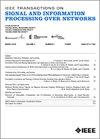Distributed Optimization for Estimation and Communication Co-Design Under Bandwidth Constraints
IF 3
3区 计算机科学
Q2 ENGINEERING, ELECTRICAL & ELECTRONIC
IEEE Transactions on Signal and Information Processing over Networks
Pub Date : 2025-08-28
DOI:10.1109/TSIPN.2025.3603740
引用次数: 0
Abstract
In the Industrial Internet of Things (IIoT), multiple sensors are deployed in production sites to perform state estimation of large-scale physical systems, which is important to ensure the stable operation of the production process. Sensors can only transmit quantized local information composed of a finite number of bits, where more quantization bits improve estimation accuracy. However, ensuring the necessary data rate for such data transmission under bandwidth limitations requires larger transmission power, increasing the energy consumption of sensors. To address this trade-off, this paper considers the co-design of estimation and communication, where the data rate and transmission power are jointly allocated to minimize a weighted estimation-communication cost while satisfying the minimum data rate constraint. An带宽约束下估计与通信协同设计的分布式优化
在工业物联网(IIoT)中,在生产现场部署多个传感器,对大规模物理系统进行状态估计,这对于保证生产过程的稳定运行至关重要。传感器只能传输由有限位组成的量化局部信息,其中更多的量化位可以提高估计精度。但是,在带宽限制的情况下,要保证这种数据传输所需的数据速率,需要更大的传输功率,增加了传感器的能耗。为了解决这种权衡,本文考虑了估计和通信的协同设计,其中数据速率和传输功率共同分配,以最小化加权估计-通信成本,同时满足最小数据速率约束。针对混合整数非线性规划问题,设计了一种基于$\ well _{p}$-box交替方向乘法器(ADMM)的分布式优化方法,并证明了该方法的全局收敛性。此外,为了保证估计误差在最小数据速率下收敛,提出了一种分布式估计算法,并通过调整估计增益来平衡估计误差的最终界和收敛率。热轧过程的数值实例研究表明了所提出的分布式优化和估计方法的优越性。
本文章由计算机程序翻译,如有差异,请以英文原文为准。
求助全文
约1分钟内获得全文
求助全文
来源期刊

IEEE Transactions on Signal and Information Processing over Networks
Computer Science-Computer Networks and Communications
CiteScore
5.80
自引率
12.50%
发文量
56
期刊介绍:
The IEEE Transactions on Signal and Information Processing over Networks publishes high-quality papers that extend the classical notions of processing of signals defined over vector spaces (e.g. time and space) to processing of signals and information (data) defined over networks, potentially dynamically varying. In signal processing over networks, the topology of the network may define structural relationships in the data, or may constrain processing of the data. Topics include distributed algorithms for filtering, detection, estimation, adaptation and learning, model selection, data fusion, and diffusion or evolution of information over such networks, and applications of distributed signal processing.
 求助内容:
求助内容: 应助结果提醒方式:
应助结果提醒方式:


